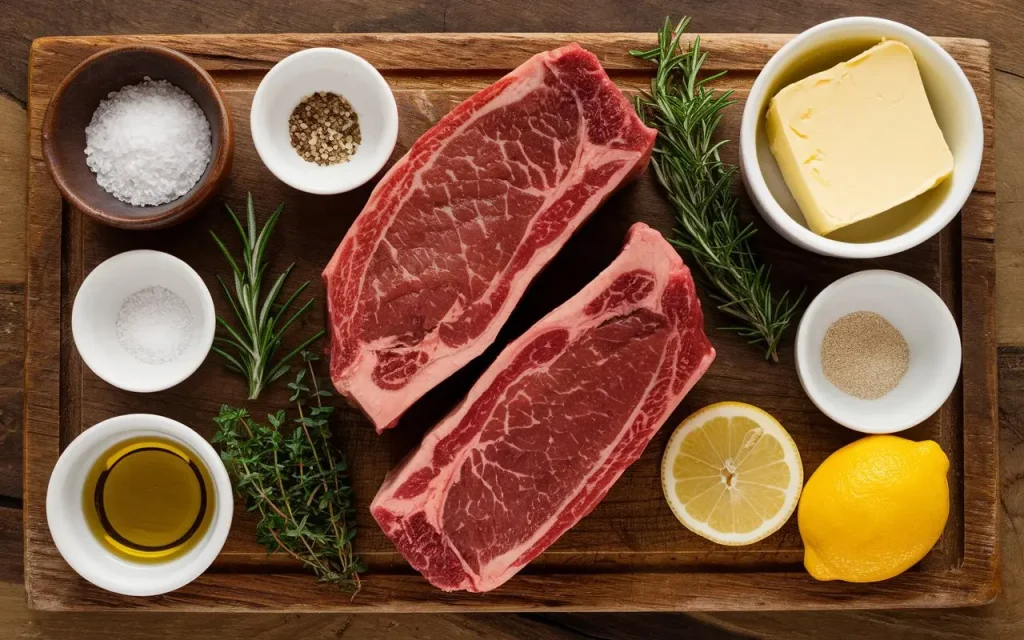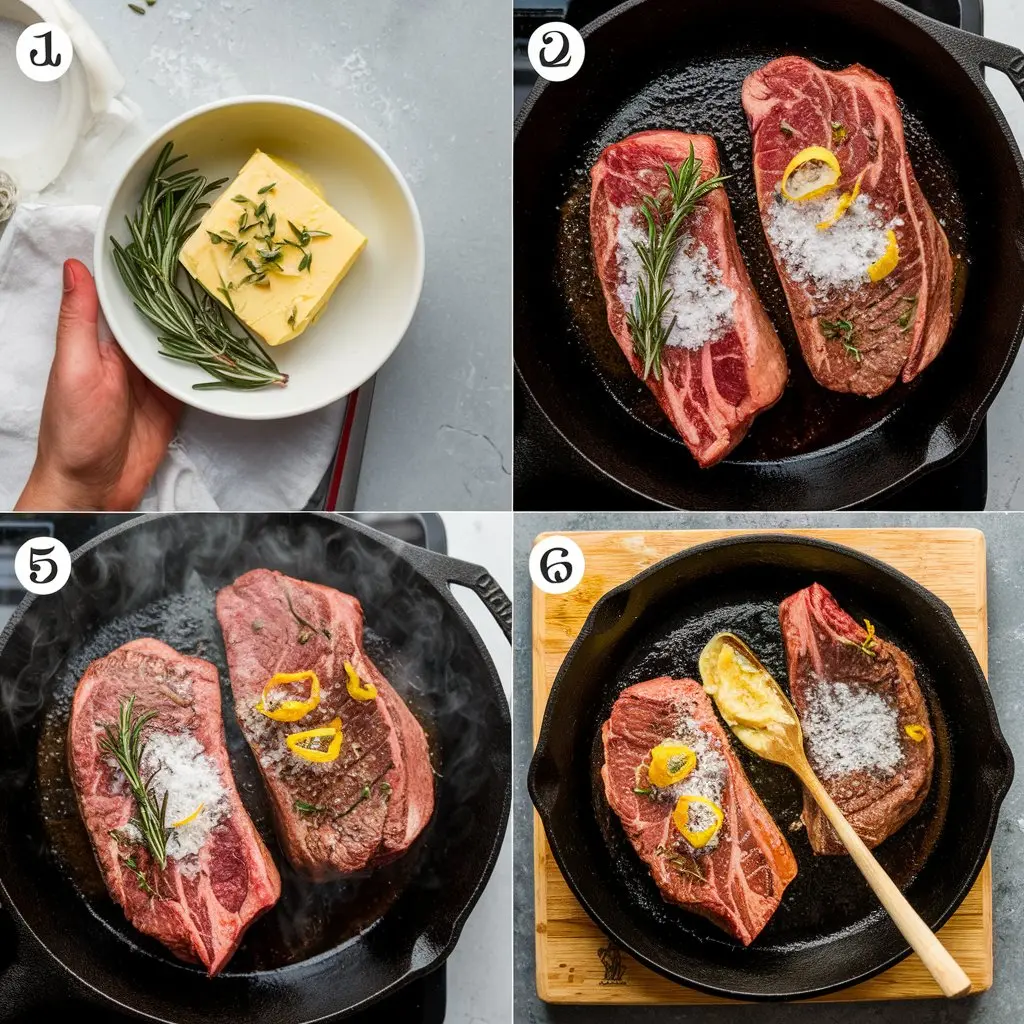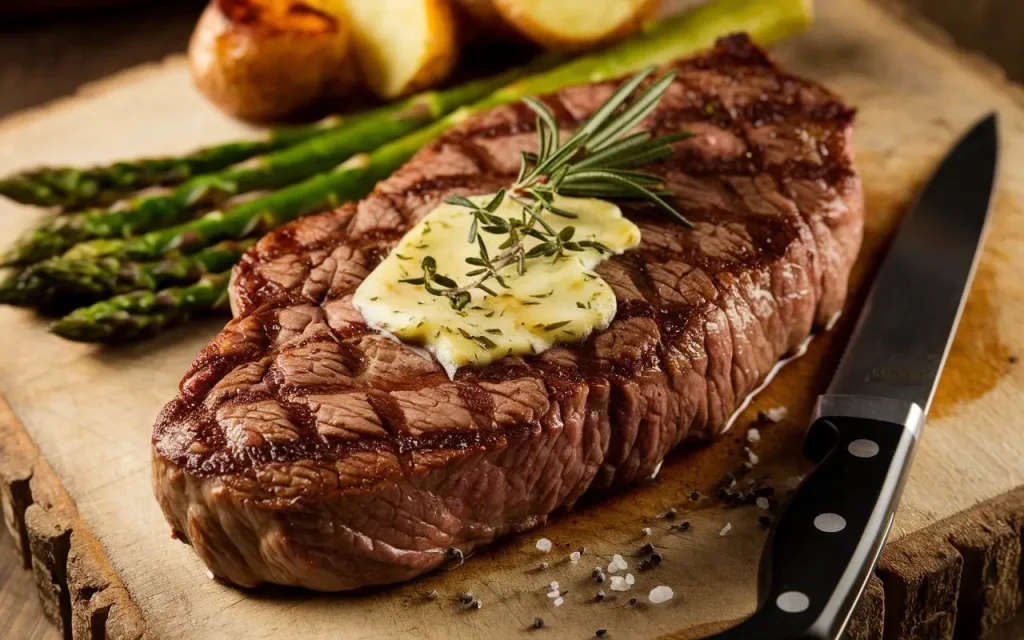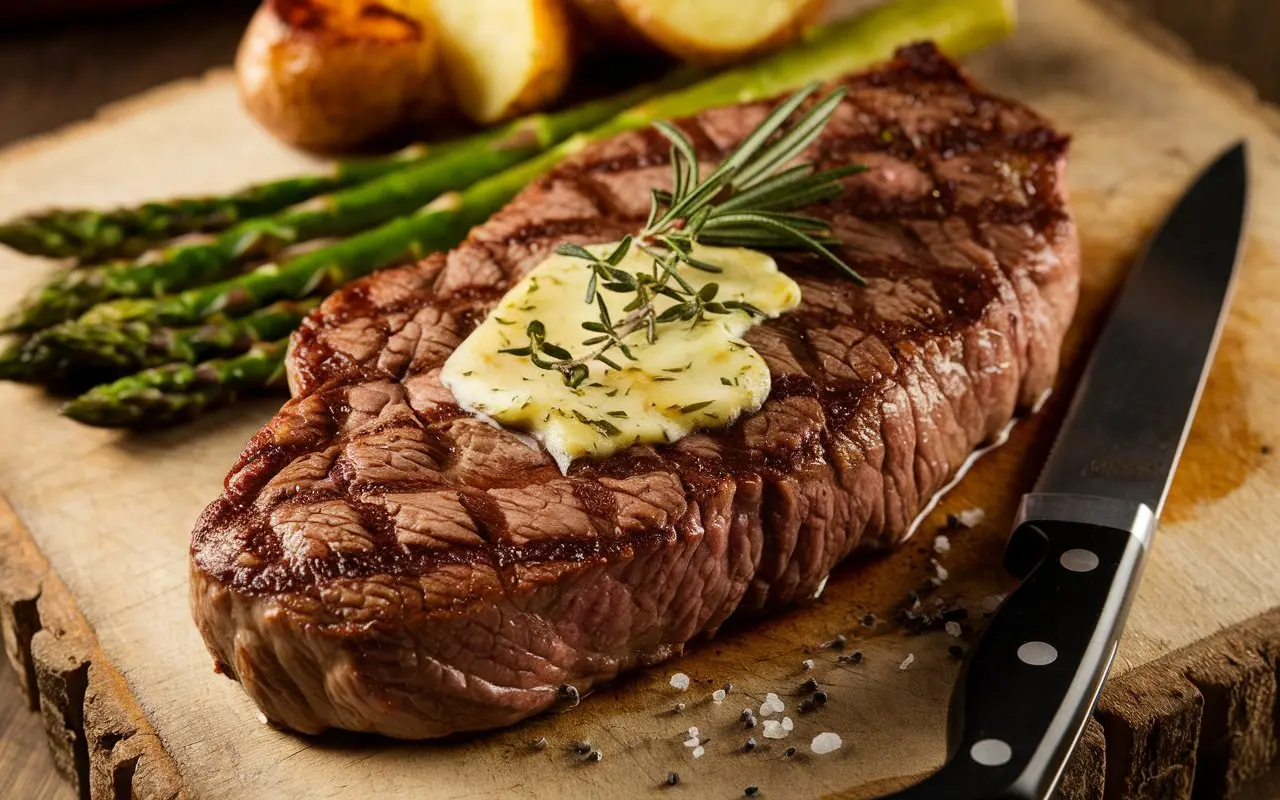New York Strip Steak with Garlic Butter Recipe
There’s something truly special about a perfectly cooked steak. Whether it’s a treat for a special occasion, a weekend indulgence, or just an evening to reward yourself, a New York Strip Steak with Garlic Butter recipe can make any meal feel like a luxurious experience. The New York Strip Steak, renowned for its rich flavor, tenderness, and perfect fat marbling, is ideal for the home cook aiming to impress with minimal ingredients but maximum impact.
In this article, we’ll dive deep into everything you need to know about making an exquisite New York Strip Steak with Garlic Butter. From understanding the history of this delicious cut to learning the best methods to cook it, and even exploring the best sides to serve, this comprehensive guide will provide all the knowledge and techniques you need to create a truly memorable steak dinner.
Internal Link Suggestion: If you’re looking for something special to serve after the steak, consider our recipe for Easy Grinch Cake, which makes a fun and whimsical dessert that both adults and kids can enjoy.
The History of the New York Strip Steak
The New York Strip Steak has a long and storied history, deeply connected to the evolution of steakhouses in the United States. This cut of beef is traditionally sourced from the short loin of the cow, which is located just behind the ribs. The New York Strip is often praised for its balance of tenderness and flavor, largely due to the fine marbling of fat throughout the meat.
Origins in New York City
The name “New York Strip Steak” is closely associated with the classic steakhouses of New York City. One of the first mentions of this particular cut is linked to Delmonico’s, an iconic New York City steakhouse that opened its doors in 1837. Their version of this steak, which they called the “Delmonico steak,” quickly gained popularity for its juicy tenderness and became synonymous with the high-quality steak dishes that steakhouses would later serve.
The American Steakhouse Experience
The popularity of the New York Strip Steak spread across America as steakhouses became increasingly popular in the late 19th and early 20th centuries. Today, the New York Strip is one of the most popular cuts for grilling or pan-searing, beloved for its succulent texture and full-bodied flavor.
Internal Link Suggestion: If you enjoy exploring iconic American dishes, you might also enjoy our Hamburger Casserole which combines comforting flavors in a nostalgic dish perfect for family gatherings.
Ingredients for a Flavorful Meal
The key to a great New York Strip Steak lies in the quality of your ingredients. Each ingredient plays a specific role in building layers of flavor that will ultimately make this dish shine.
Essential Ingredients
- New York Strip Steaks (2, 10-12 oz each): Look for steaks that have good marbling; the fat should be distributed evenly throughout the meat. This will ensure tenderness and flavor.
- Kosher Salt and Freshly Ground Black Pepper: Seasoning your steak is crucial. Coarse salt helps form a crust, while pepper adds a layer of spice.
- Olive Oil (2 Tablespoons): This oil has a relatively high smoke point, perfect for searing.
- Unsalted Butter (4 Tablespoons): Butter adds richness. Unsalted butter allows you to control the saltiness.
- Garlic (5 Cloves, minced): Garlic is essential for the signature garlic butter flavor.
- Fresh Herbs (Rosemary, Thyme): These herbs bring out the natural flavors of the steak.
- Lemon Zest (1): Adding lemon zest enhances freshness, balancing out the richness of the steak.

Internal Link Suggestion: To enhance your garlic butter, consider using similar techniques from our Garlic Butter Crab Claws, which adds complexity through aromatic herbs and citrus.
Optional Side Ingredients
- Roasted Potatoes: For a classic steakhouse experience.
- Grilled Asparagus: The crispness and slight bitterness of asparagus balance the richness of the steak.
- Creamed Spinach: This classic side provides a creamy texture that pairs well with the steak.
Culinary Science Behind Steak Cooking
To truly master the New York Strip Steak, it’s helpful to understand a bit of the culinary science behind cooking steak. Cooking a steak is about managing heat and allowing for chemical reactions to take place to create depth of flavor.
Maillard Reaction: The Secret to Flavor
The Maillard reaction is a chemical reaction between amino acids and reducing sugars that gives browned foods their distinctive flavor. When you sear your New York Strip Steak, this reaction occurs, creating a golden-brown crust full of complex flavors. The key is to use high heat and avoid moving the steak too much, allowing the crust to develop properly.
Resting: Locking in the Juices
After cooking, the steak should rest for about 5-10 minutes. During cooking, the juices in the meat move toward the center, and resting allows these juices to redistribute evenly, ensuring every bite is juicy.
Internal Link Suggestion: If you want to master more cooking techniques, check out our guide on Mastering Barbecue Baby Back Ribs which will teach you the essentials of slow cooking and flavor layering.
Step-by-Step Guide to the Perfect New York Strip Steak
1: Preparing the Garlic Butter
The garlic butter is the magic touch that takes this steak from good to gourmet.
- Mix the Ingredients: In a small bowl, combine the softened butter, minced garlic, chopped rosemary, thyme, and lemon zest.
- Shape and Chill: Place the butter mixture on a piece of plastic wrap, roll it into a log, and refrigerate until firm. Chilling makes it easier to slice and ensures even distribution when melting.
Internal Link Suggestion: This garlic butter preparation technique is also useful for our Tequila Lime Shrimp Recipe, where flavored butter helps bring out the seafood’s zestiness.
2: Seasoning and Preparing the Steak
- Room Temperature Matters: Take the steaks out of the fridge at least 30 minutes before cooking. Cooking a cold steak can result in an uneven cook.
- Season Generously: Pat the steaks dry using a paper towel to ensure a good sear. Then season generously with kosher salt and freshly ground black pepper. The salt helps to form a crust that locks in the juices and gives the steak its signature texture.
Internal Link Suggestion: For more insight into seasoning blends, consider reading our Beef Stew Seasoning Guide, which details how to achieve perfectly balanced flavors in savory dishes.
3: Cooking the Steak
- Heat the Pan: Use a heavy-bottomed skillet, preferably cast iron. Heat it on medium-high until it is almost smoking hot.
- Add Oil and Sear the Steak: Add olive oil and lay the steak down gently. Let it cook without moving for 3-4 minutes. This sears the steak and forms that beautiful crust.
- Flip and Baste: Turn the steak over. Add the prepared garlic butter to the skillet. As it melts, use a spoon to baste the butter over the steak repeatedly. This process infuses the meat with the garlic-herb flavor.
- Check Temperature: Insert an instant-read thermometer into the thickest part of the steak. For medium-rare, the internal temperature should read 130-135°F.
4: Let It Rest
Transfer the steaks to a cutting board and let them rest for 5-10 minutes before slicing. Resting ensures that all the flavorful juices are retained within the steak.
Internal Link Suggestion: Resting and serving techniques are also essential for our Ultimate Croissant Sandwich, as careful preparation and resting lead to a more satisfying texture and taste.

Side Dish Suggestions
Pairing the right side dishes with your New York Strip Steak can elevate the entire meal. Here are some ideas that complement the robust flavors of the steak perfectly:
Creamed Spinach
Creamed spinach adds
a layer of creaminess to contrast with the steak’s deep flavors. The mild bitterness of the spinach combined with the rich cream sauce balances out the robust taste of the steak.
Roasted Vegetables
Vegetables like bell peppers, zucchini, and onions work wonderfully roasted alongside the steak. The roasting process caramelizes their natural sugars, enhancing their flavors.
Garlic Mashed Potatoes
Mashed potatoes are a classic steakhouse side for a reason. The creaminess of mashed potatoes flavored with roasted garlic perfectly balances the intense savoriness of the steak.
Internal Link Suggestion: If you’re interested in more unconventional sides, try our Low-Calorie Mac & Cheese, a comforting yet lighter option that pairs beautifully with this steak.
The Art of Basting for Extra Flavor
How to Master Basting
Basting involves repeatedly spooning the hot, melted butter (along with herbs and garlic) over the meat as it cooks. This technique:
- Adds Flavor: The hot fat coats the surface of the meat, adding richness.
- Cooks Evenly: It helps cook the top of the steak more evenly without flipping it too often.
- Enhances Moisture: The butter keeps the meat moist while cooking.
Internal Link Suggestion: This basting technique is similar to our approach in the Pancake Hood Recipe, where the use of butter at key stages enhances the overall flavor.
Alternative Cooking Methods
Grilling
Grilling is another fantastic way to cook New York Strip Steak. It adds a smoky element that can elevate the dish. Here’s how you can prepare it:
- Preheat Your Grill: Ensure your grill reaches 450-500°F before you start cooking.
- Direct Heat Searing: Place the steaks directly on the heat source to sear each side for 3-4 minutes.
- Indirect Heat Finish: Move the steak to a cooler part of the grill to finish cooking without burning the crust.
Internal Link Suggestion: For more grilling inspiration, check out our Ultimate Guide to Rigatoni Recipe, which includes tips on using grilling for adding charred flavors to complementary dishes.
Sous Vide
For a more hands-off approach, sous vide cooking ensures precision:
- Season and Seal: Season the steak and vacuum-seal it.
- Cook in Water Bath: Set the sous vide machine to 130°F for medium-rare and cook for 2-3 hours.
- Sear Post-Cook: After removing it from the bag, sear the steak on a hot skillet for 1-2 minutes per side for a perfect crust.
Internal Link Suggestion: Learn about other precision cooking methods like our approach to making Million Dollar Chicken Casserole for consistently tender and flavorful results.
Creating Compound Butters for Variation
Herb and Garlic Butter
A classic combination, the herb and garlic butter adds complexity to the flavor profile of the New York Strip Steak. Variations can include:
- Chili Butter: Adding chili flakes or fresh minced chili for a spicy kick.
- Blue Cheese Butter: Mix in some crumbled blue cheese to add a tangy richness.
Internal Link Suggestion: To explore more about enhancing flavors, consider the Seasoned Hand Guide, which teaches advanced seasoning techniques that can be applied to compound butters.
Conclusion: Making Your Perfect Steak Meal
Cooking the perfect New York Strip Steak with Garlic Butter is all about patience, attention to detail, and using quality ingredients. From the careful preparation of the compound butter to mastering the cooking and resting of the steak, every step contributes to the final burst of flavors.

The beauty of this recipe lies in its versatility. You can customize the flavors, experiment with sides, and even use different cooking methods based on your preference. This guide should empower you to not only cook a delicious steak but to also develop a deeper appreciation for the ingredients and techniques used.
Internal Link Suggestion: If you are planning a complete steakhouse-style dinner, don’t forget to browse through our Sweet Potato Shrimp Grits Recipe as a creative side that blends sweet, creamy, and spicy flavors, offering a unique Southern twist to your steak night.
Additional Resources
- Cooking Times Chart: Remember, the ideal steak is all about timing. Keep a handy chart of temperatures and times to ensure your steak is always cooked to your liking.
- Meat Quality Guide: Understanding how to choose quality cuts can make a huge difference in the final dish.
- Seasoning Practices: Experiment with different herbs and spices to develop a signature flavor.
Enjoy cooking and relish every bite of your well-prepared, garlic-butter-covered New York Strip Steak!

